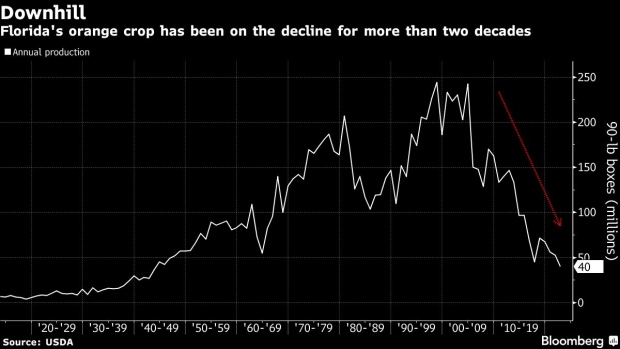May 27, 2022
Florida’s Shrinking Orange Crop Faces Hyperactive Storm Season
, Bloomberg News

(Bloomberg) -- A record seventh hyperactive hurricane season is about to start in the Atlantic Ocean, putting pressure on Florida’s reign as the top US orange producer.
The US National Weather Service is forecasting 14 to 21 named storms to spin across the Atlantic during the six-month season that starts June 1.
The outlook is the latest from academic and commercial sources pointing to an overactive year across the basin. Among the others, Colorado State University, which pioneered seasonal forecasts, called for 19 storms, while AccuWeather Inc. has estimated 16 to 20.
Already, growers are facing one of the lowest crops on record, partly because of a decades-long battle with a devastating disease called citrus greening that damages fruit and eventually kills trees.
A major weather event in Florida would be problematic both in the short and long term, given that investments in groves have been limited and production has been declining every year, said Andres Padilla, an analyst at Rabobank International. A big hit “would make it harder for some existing farmers to remain in production.”
Florida’s crop problems, coupled with production issues in top grower Brazil, have sent orange juice futures soaring 55% in New York over the past year to around $1.82 a pound. Prices could breach $2 a pound should a big hurricane hit, Padilla said.
To be sure, Florida’s citrus crops have avoided the kind of direct strike that can tear trees out of the ground, said Don Keeney, a meteorologist with Maxar Technologies Inc. Production has also shrunk to less than one-fifth of what it was at the beginning of the century and planted acreage is a smaller portion of what it was at its peak.
But the few acres that remain are crucial for an industry facing soaring costs, including transportation. Lower output will likely mean bigger imports.
At the current pace, California is poised to overtake the Sunshine State as the nation’s top grower. But California’s harvest is used mainly for the fresh-fruit market.
Since 2017, Florida has been hit by eight hurricanes and tropical storms. The average year has 14 storms named, which happens when their winds reach tropical-storm strength of 39 miles (63 kilometers) per hour.
Meanwhile Brazil, the world’s biggest grower, had its output slashed by freakish drought and frost last year, with the market worried about another dry year “that could mean revisions to the downside later on in the season,” Padilla said.
Florida’s unusually flat landscape raises the potential for a dangerous storm to rip across the central part of the state. In addition to high winds, tropical systems can dump flooding rains miles from their centers, which means even storms that don’t quite strike the state can have devastating impacts.
There’s nothing you can do to prepare, especially because an event can hit a neighbor 10 miles away and spare others, said Ray Royce, executive director at Highlands County Growers Association, which represents about 15% of the state’s planted acreage. A hailstorm and a cold snap earlier this year probably already hurt the outlook for the 2022-23 crop, he said.
“Growers will try to do what they can to make the trees as strong as possible to withstand stress,” Royce said. “They want to have a good crop.”
©2022 Bloomberg L.P.





